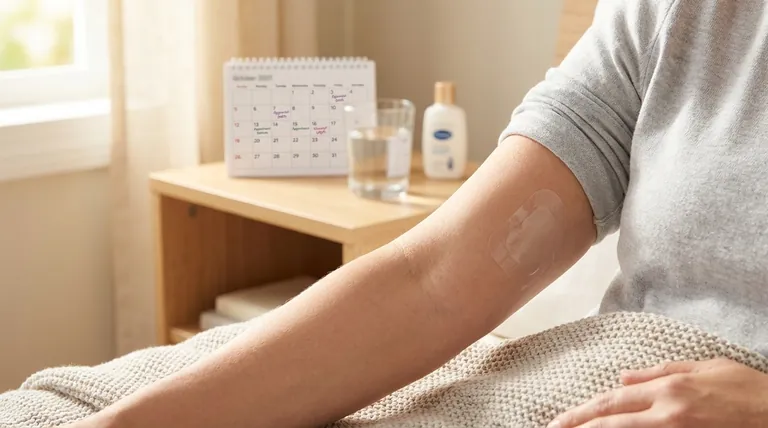The granisetron skin patch is a preventative tool used specifically to stop nausea and vomiting before they start in patients undergoing cancer chemotherapy. It is designed for multi-day use, providing continuous medication for individuals receiving chemotherapy regimens known to cause moderate to severe nausea over several consecutive days.
The core function of the granisetron patch is not to treat existing nausea, but to provide a steady, proactive defense against it. Its effectiveness hinges on correct application before chemotherapy begins and adherence to specific lifestyle precautions while it is worn.

How Granisetron Works: A Protective Shield
The patch delivers medication through the skin, offering a consistent and convenient way to manage one of chemotherapy's most challenging side effects.
Blocking Nausea Signals
Granisetron belongs to a class of drugs that work by blocking specific substances in the body, like serotonin, that can trigger nausea and vomiting. By intercepting these signals, the medication prevents the brain from receiving the message to feel nauseous.
The Advantage of a Patch
Unlike a pill, a transdermal patch provides a slow, continuous release of the drug over several days. This maintains a steady level of medication in your system, offering prolonged protection that aligns with multi-day chemotherapy cycles.
Correct Application for Maximum Efficacy
Proper application is essential for the patch to work as intended. It should be applied to clean, dry, healthy skin, typically on the upper outer arm.
Step-by-Step Application
- Remove the patch from its foil pouch; do not cut it.
- Peel the protective liner from the sticky adhesive side in two pieces.
- Apply the sticky side to the skin and press down firmly for several seconds to ensure it is secure.
- Wash your hands immediately after applying the patch.
Managing a Loose Patch
If the edges of the patch begin to lift, you can secure them with medical adhesive tape or a surgical bandage. However, you should never cover the entire patch, as this can interfere with how the medication is delivered.
Understanding the Trade-offs and Side Effects
While effective, the granisetron patch comes with potential side effects and necessary precautions that must be followed.
Common Side Effects
The most frequently reported side effect is constipation. Other reactions can include skin irritation at the application site, headache, or trouble sleeping. Some side effects, like decreased appetite, may not require immediate medical attention.
When to Seek Medical Attention
Contact your doctor if you experience more severe side effects, such as a very fast heartbeat, anxiety, muscle spasms, high fever, or severe diarrhea.
Critical Lifestyle Adjustments
While wearing the patch, you must avoid certain activities to ensure it remains effective and secure.
- Avoid prolonged water exposure: This includes long baths, swimming, saunas, and whirlpools.
- Limit strenuous exercise: Excessive sweating can cause the patch to loosen.
- Protect the site from sunlight: The application area must be kept out of direct sunlight while wearing the patch and for 10 days after it is removed.
Key Considerations Before Use
The decision to use this medication involves weighing its benefits against potential risks, which should be discussed thoroughly with your healthcare provider.
Specific Patient Populations
Studies have not established the safety and efficacy of the granisetron patch for pediatric patients. While no specific problems have been documented in geriatric patients, caution is advised as age-related heart, kidney, or liver issues may be present.
Discussing Your Medical History
It is critical to inform your doctor of any allergies, other medical conditions, and all other medications you are taking. This ensures the granisetron patch is a safe and appropriate choice for your specific situation.
Making the Right Choice for Your Goal
- If your primary focus is preventing chemotherapy-induced nausea: Apply the patch 24 to 48 hours before your first chemotherapy dose for maximum protection.
- If your primary focus is safety and avoiding complications: Strictly follow the lifestyle limitations, especially regarding water and sun exposure, and report any severe side effects immediately.
- If you are a caregiver assisting a patient: Pay close attention to proper patch application and help monitor for both skin reactions and systemic side effects like constipation.
Properly understood and applied, the granisetron patch can be a critical component in managing your treatment journey.
Summary Table:
| Key Aspect | Details |
|---|---|
| Primary Use | Prevents nausea/vomiting from multi-day chemotherapy regimens. |
| How It Works | Continuously releases granisetron through the skin to block nausea signals. |
| Application | Apply to upper outer arm 24-48 hours before chemotherapy starts. |
| Key Consideration | Not for treating existing nausea; requires lifestyle adjustments (e.g., avoid prolonged water exposure). |
| Common Side Effect | Constipation. |
Are you a healthcare or pharmaceutical distributor seeking a reliable manufacturing partner for transdermal patches like granisetron?
At Enokon, we are a bulk manufacturer of high-quality, reliable transdermal patches and pain plasters. We specialize in custom R&D and development to meet your specific product needs. Our technical expertise ensures you get effective, patient-centric solutions.
Contact our team today to discuss your custom transdermal patch development project.
Visual Guide

Related Products
- Natural Herbal Wormwood Patch Pain Plaster
- Far Infrared Deep Heat Relief Patches Medicated Pain Relief Patches
- Capsaicin Chili Medicated Pain Relief Patches
- Mugwort Wormwood Pain Relief Patch for Neck Pain
- Lidocaine Hydrogel Pain Relief Patch for Pain Relief
People Also Ask
- What was the reported pain relief after the initial month of plaster use? Consistent & Effective Pain Management
- When should the pain relief patch not be used? Key Safety Rules to Avoid Risks
- How do pain relief patches work? A Guide to Targeted, Long-Lasting Pain Relief
- Are pain relief patches safe for sensitive skin? Your Guide to Safe Use & Skin Testing
- What precautions should be taken when using pain relief patches? Essential Safety Guide












